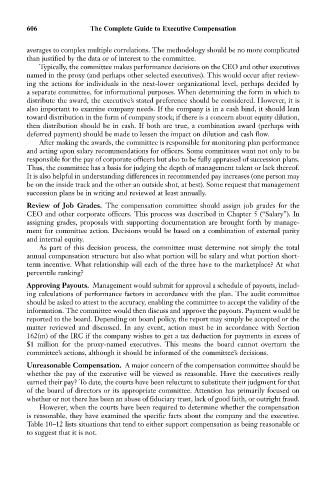Page 621 - Bruce Ellig - The Complete Guide to Executive Compensation (2007)
P. 621
606 The Complete Guide to Executive Compensation
averages to complex multiple correlations. The methodology should be no more complicated
than justified by the data or of interest to the committee.
Typically, the committee makes performance decisions on the CEO and other executives
named in the proxy (and perhaps other selected executives). This would occur after review-
ing the actions for individuals in the next-lower organizational level, perhaps decided by
a separate committee, for informational purposes. When determining the form in which to
distribute the award, the executive’s stated preference should be considered. However, it is
also important to examine company needs. If the company is in a cash bind, it should lean
toward distribution in the form of company stock; if there is a concern about equity dilution,
then distribution should be in cash. If both are true, a combination award (perhaps with
deferred payment) should be made to lessen the impact on dilution and cash flow.
After making the awards, the committee is responsible for monitoring plan performance
and acting upon salary recommendations for officers. Some committees want not only to be
responsible for the pay of corporate officers but also to be fully appraised of succession plans.
Thus, the committee has a basis for judging the depth of management talent or lack thereof.
It is also helpful in understanding differences in recommended pay increases (one person may
be on the inside track and the other an outside shot, at best). Some request that management
succession plans be in writing and reviewed at least annually.
Review of Job Grades. The compensation committee should assign job grades for the
CEO and other corporate officers. This process was described in Chapter 5 (“Salary”). In
assigning grades, proposals with supporting documentation are brought forth by manage-
ment for committee action. Decisions would be based on a combination of external parity
and internal equity.
As part of this decision process, the committee must determine not simply the total
annual compensation structure but also what portion will be salary and what portion short-
term incentive. What relationship will each of the three have to the marketplace? At what
percentile ranking?
Approving Payouts. Management would submit for approval a schedule of payouts, includ-
ing calculations of performance factors in accordance with the plan. The audit committee
should be asked to attest to the accuracy, enabling the committee to accept the validity of the
information. The committee would then discuss and approve the payouts. Payment would be
reported to the board. Depending on board policy, the report may simply be accepted or the
matter reviewed and discussed. In any event, action must be in accordance with Section
162(m) of the IRC if the company wishes to get a tax deduction for payments in excess of
$1 million for the proxy-named executives. This means the board cannot overturn the
committee’s actions, although it should be informed of the committee’s decisions.
Unreasonable Compensation. A major concern of the compensation committee should be
whether the pay of the executive will be viewed as reasonable. Have the executives really
earned their pay? To date, the courts have been reluctant to substitute their judgment for that
of the board of directors or its appropriate committee. Attention has primarily focused on
whether or not there has been an abuse of fiduciary trust, lack of good faith, or outright fraud.
However, when the courts have been required to determine whether the compensation
is reasonable, they have examined the specific facts about the company and the executive.
Table 10–12 lists situations that tend to either support compensation as being reasonable or
to suggest that it is not.

